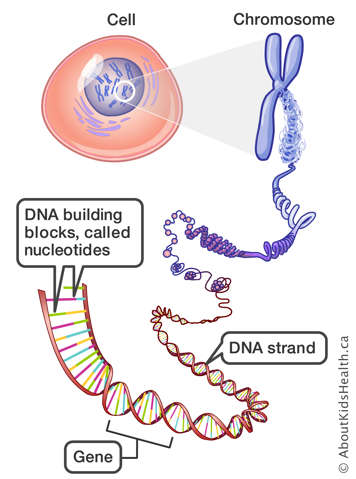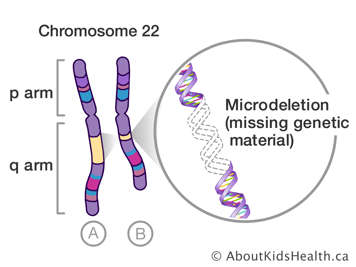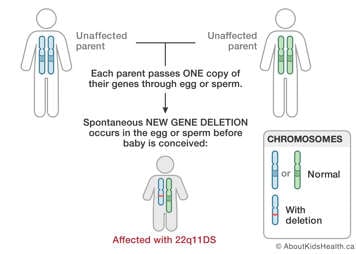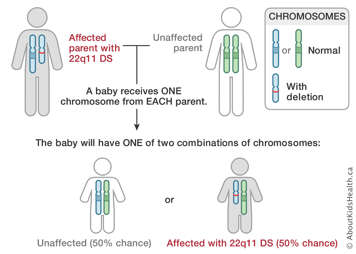What is 22q11 deletion syndrome?
22q11 deletion syndrome (22q11DS) is a genetic condition that affects about 1 in 2000 to 1 in 4000 children. 22q11DS is known by several other names including velo-cardio-facial syndrome (VCFS) and DiGeorge syndrome.
22q11DS can affect many parts of the body including:
- the heart
- the immune system
- the palate (roof of the mouth).
It can also affect how a person learns.
Causes of 22q11DS

Chromosome deletion
DNA carries a person’s genetic information. DNA is organized into structures called chromosomes. Each cell of the body contains the same number of chromosomes and all of a person’s genetic information. Humans have 46 chromosomes arranged in 23 pairs, with two copies of each chromosome.
Chromosomes carry all of our genes. Genes determine how a person will grow and develop. Missing genetic information (such as a chromosome deletion) can lead to medical and developmental problems. How a person’s development or health will be affected depends on which genetic material is missing.
All chromosomes have a long (q) arm and a short (p) arm. People typically have two copies of chromosome 22. People with 22q11DS have a small piece of genetic material (genes) missing on the q arm of one of their two copies of chromosome 22. This is sometimes called a deletion. Even though it is small, the deletion of the 22q11.2 chromosome region involves many genes and can affect many parts of the body.

How did your child get 22q11DS?
Most of the time, 22q11DS is the result of a new genetic deletion that occurs when a baby is conceived. This is called a de novo deletion and occurs by chance in either the mom’s egg or the dad’s sperm. A de novo deletion is not caused by anything the parents did before or during the pregnancy. For parents who have a child with a de novo deletion, the chance of having another child with 22q11DS is low.

In some people with 22q11DS (about 10%), the deletion is inherited from a parent. Sometimes a parent might not know that they have 22q11DS until after they have a child diagnosed with this condition. A person who has 22q11DS has a 50% chance (1 in 2) of having a child with 22q11DS.

You can speak to a genetic counsellor to discuss information regarding how 22q11DS happened in your family and your chances of having a child with 22q11DS.
How 22q11DS is diagnosed
If the doctor suspects that a child has 22q11DS, they may order genetic testing. Today, three different tests are able to detect 22q11DS. Each requires a small sample of blood. Some tests look for the 22q11 deletion; others look generally at the chromosomes structures for any deletion or duplication of genetic material.
Only one of these tests is typically needed to make a diagnosis of 22q11DS. The test that is ordered by your child's doctor is chosen based on your child’s presentation.
It usually takes several weeks to get these test results back depending on the test chosen and the laboratory. Ask your health-care provider about your specific situation.
These tests include:
FISH (fluorescent in situ hybridization)
Fluorescent In Situ Hybridization (FISH) is a test that looks specifically for a deletion on chromosome 22. This test can miss small or atypical 22q11 deletions.
Chromosomal microarray
Chromosome microarray is a test that looks for extra or missing pieces across all the chromosomes. This test can detect small or atypical 22q11 deletions.
MLPA
MLPA is a DNA test that looks for missing or extra pieces in chromosome region 22q11. This test can detect small or atypical 22q11 deletions.